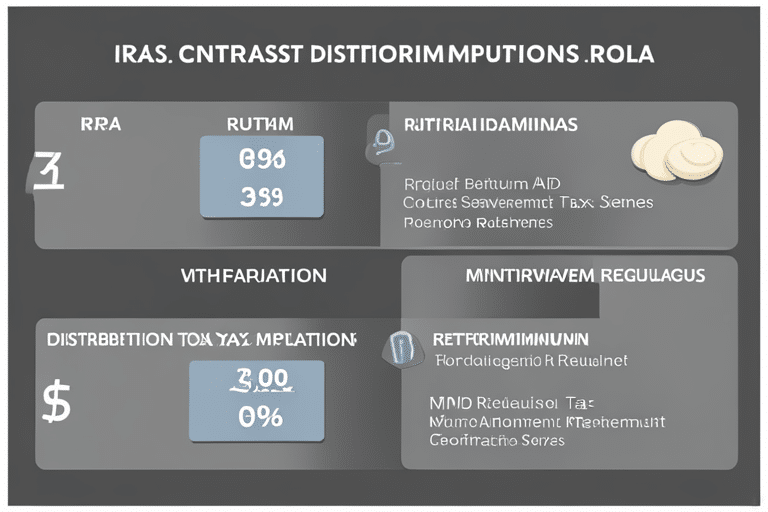Are you ready to dive into the world of retirement savings? Well, buckle up because we’re about to break down the differences and benefits between a Traditional IRA and a Roth IRA.
Which one is right for you? Can’t decide? Don’t worry, we’ve got you covered.
In this article, we’ll guide you through the eligibility requirements, contribution limits, tax deductibility, growth potential, and more.
So grab your thinking cap and let’s unravel this financial maze together!
Key Takeaways
- Traditional IRA eligibility is based on earned income, while Roth IRA eligibility requires both earned income and MAGI limits based on filing status.
- Contributions to a Traditional IRA may be tax-deductible, while Roth IRAs offer tax-free growth and withdrawals in retirement.
- Roth IRAs have impressive growth potential with tax-free growth over time, while Traditional IRAs require taxes to be paid on gains, limiting growth potential.
- Strategies for managing Required Minimum Distributions (RMDs) and penalties include stretching out withdrawals, making charitable contributions, converting to a Roth IRA, and consulting with a financial expert.
Eligibility for Traditional and Roth IRAs

You can determine your eligibility for both a traditional IRA and a Roth IRA based on certain income and filing status requirements. It’s like trying to fit into that pair of skinny jeans you bought years ago – there are limitations, my friend. But fear not, for I am here to guide you through this confusing maze of eligibility requirements.
Let’s start with the traditional IRA. To be eligible for this retirement account, you must have earned income from a job or self-employment. Sorry, but those winnings from your weekly poker game don’t count! Additionally, if you’re single or head of household, your modified adjusted gross income (MAGI) must be below a certain limit. If you’re married and file jointly, the MAGI limit is higher.
Now let’s talk about the Roth IRA. This bad boy has its own set of rules when it comes to eligibility. Just like with the traditional IRA, you need earned income to qualify. However, there’s an added twist – your MAGI must also fall within specific limits based on your filing status.
But wait! There’s more! If your income exceeds these limits for either type of IRA, all hope is not lost! You may still be able to contribute indirectly by using what some call the ‘backdoor’ method. It involves making non-deductible contributions to a traditional IRA and then converting them into a Roth IRA.
Contribution Limits for Traditional and Roth IRAs

The contribution limits for both types of IRAs are set by the IRS. But don’t worry, it’s not as complicated as it sounds. Let’s break it down in a language that even the IRS would find entertaining!
When it comes to contributing to your IRA, there are some rules you need to follow. The table below shows the current contribution limits for both Traditional and Roth IRAs:
| Contribution Limit | Additional Catch-Up Contribution (Age 50+) | |
|---|---|---|
| Traditional IRA | $6,000 per year | $1,000 |
| Roth IRA | $6,000 per year | $1,000 |
Now that we’ve got those numbers out of the way, let’s talk about income requirements. For Traditional IRAs, anyone with earned income can contribute regardless of their income level. However, things get a little trickier with Roth IRAs.
With a Roth IRA, your ability to contribute is subject to income limits. If you’re single or head of household and your modified adjusted gross income (MAGI) is above $140,000, you won’t be able to make any contributions directly into a Roth IRA. For married couples filing jointly, the limit is $208,000.
So remember: if you want to max out your contributions and enjoy all the benefits of an IRA account without worrying about income restrictions or tax penalties down the line, keep these contribution limits and income requirements in mind.
Speaking of taxes… let’s move on to the next section where we’ll discuss the tax deductibility of traditional IRA contributions!
Tax Deductibility of Traditional IRA Contributions

Let’s take a look at the tax deductibility of contributions made to a Traditional IRA.
Ah, taxes, the bane of our existence! But fear not, dear reader, for I am here to unravel the mysteries of tax deductibility and make it as delightful as a walk in the park on a sunny day.
Now, imagine this: you’re sitting at your desk, staring at a pile of papers that resemble hieroglyphics more than anything else. Suddenly, a light bulb goes off in your head! You remember that contributing to a Traditional IRA can have some serious tax benefits. Huzzah!
Here’s the deal: when you contribute to a Traditional IRA, you may be able to deduct your contributions from your taxable income. It’s like waving a magic wand and poof! Your taxable income shrinks before your very eyes.
But hold on just a moment before you start celebrating with an impromptu dance party. There are some rules and limitations to keep in mind. The amount of money you can deduct depends on various factors such as your filing status, modified adjusted gross income (MAGI), and whether or not you or your spouse have access to an employer-sponsored retirement plan.
In general, if neither you nor your spouse have access to an employer plan, all of your contributions are usually deductible. However, if either one of you does have access to such a plan, then things get slightly trickier.
Tax-Free Growth in a Roth IRA

So you’re thinking about diving into the world of Roth IRAs, huh? Well, buckle up because we’re about to take a wild ride filled with tax benefits, growth potential, and some seriously advantageous tax-free growth.
With a Roth IRA, not only do you get the joy of enjoying your retirement without worrying about taxes (yay!), but you also have the opportunity for your money to grow over time (cha-ching!).
Tax Benefits of Roth
One major advantage of a Roth IRA is that you don’t have to pay taxes on qualified withdrawals in retirement. It’s like having your own magical money tree that grows tax-free!
Picture this: you plant the seed of your hard-earned cash into your Roth IRA and watch it sprout into a beautiful, bountiful tree. As time goes by, the branches of tax-free growth stretch towards the sky, filling your retirement nest egg with sweet, untaxed fruits.
Meanwhile, all around you, people with traditional IRAs are stuck paying taxes on their hard-earned gains. But not you! With a Roth IRA, you can enjoy the advantages of tax-free growth and let that money grow and grow without Uncle Sam taking a bite out of it.
It’s like having your cake and eating it too – but without any extra calories or tax implications!
Growth Potential With Roth
The growth potential of a Roth IRA is impressive, as your money can grow tax-free over time. It’s like planting a money tree and watching it bloom into a forest of cash.
Here are four reasons why a Roth IRA is the secret sauce to turbocharge your retirement savings:
-
No taxes on qualified withdrawals: When you’re ready to retire and start enjoying the fruits of your labor, you won’t have to pay Uncle Sam any extra dough. It’s like having an all-you-can-eat buffet without the bill.
-
More control over your investments: With a Roth IRA, you get to choose where your money goes. You’re not stuck with some boring old mutual fund that barely moves the needle. Take charge and invest in what excites you!
-
Flexibility for emergencies: Life happens, unexpected expenses come knocking at your door – but fear not! With a Roth IRA, you can withdraw your contributions penalty-free in case of an emergency. It’s like having a financial safety net.
-
Passing on wealth to loved ones: A Roth IRA allows you to leave behind a legacy for generations to come. Your heirs will receive your funds tax-free, giving them one less thing to worry about.
Advantages of Tax-Free Growth
Ah, the sweet sound of tax advantages and long-term savings. Who doesn’t love those? Well, my friend, when it comes to Roth IRAs, you’re in for a treat. The advantages of tax-free growth are like finding a hidden stash of chocolate in your sock drawer – pure delight.
Let me break it down for you with a nifty little table:
| Traditional IRA | Roth IRA |
|---|---|
| Contributions are tax-deductible | Contributions are not tax-deductible |
| Pay taxes on withdrawals | Withdrawals are tax-free |
| Required Minimum Distributions (RMDs) at age 72 | No RMDs during your lifetime |
With a Roth IRA, you get to enjoy the double whammy of tax-free contributions and withdrawals. It’s like having your cake and eating it too! Plus, since there are no RMDs to worry about, you can let your money grow and compound over time – just like that never-ending bowl of guacamole at the party.
Required Minimum Distributions (RMDs) for Traditional IRAs

When you reach the age of 70 and a half, you must start taking RMDs from your traditional IRA. Don’t worry, it’s not as scary as it sounds! In fact, there are some strategies for managing RMDs that can actually make them work in your favor. Here are a few ideas to get you started:
-
RMDs: The Necessary Evil: Required Minimum Distributions (RMDs) may be mandatory, but they don’t have to ruin your retirement. With a little planning and creativity, you can make the most of this requirement.
-
Stretch It Out: One strategy is to take only the minimum distribution required by law. By doing so, you can keep more money in your IRA for longer and potentially benefit from continued tax-deferred growth.
-
Charitable Contributions: If you’re feeling generous and want to support a cause close to your heart, consider donating your RMD directly to a charity. Not only will this fulfill your distribution requirement, but it will also provide a tax benefit.
-
Convert to Roth IRA: Another option is converting some or all of your traditional IRA funds into a Roth IRA. While this won’t eliminate RMDs entirely, it can help manage the tax burden associated with them.
Early Withdrawal Penalties for Traditional and Roth IRAs

So, you’re thinking about dipping into your retirement savings early, huh? Well, before you start fantasizing about that trip to Bermuda or that fancy new car, let’s talk about the consequences.
Traditional IRA penalties can be quite the buzzkill, with a 10% penalty on top of income taxes if you withdraw before age 59½. On the other hand, Roth IRA penalties are a bit more forgiving, allowing for penalty-free withdrawals of contributions at any time.
Now it’s time to compare these withdrawal consequences and decide if it’s worth raiding your nest egg or if you should just stick to dreaming about piña coladas on the beach.
Traditional IRA Penalties
If you withdraw funds from your Traditional IRA before the age of 59 and a half, you may face penalties. Yikes! Nobody wants that, right? So, let’s dive into the world of Traditional IRA penalties and see what mischief awaits those who dare to make an early withdrawal.
-
The dreaded 10% penalty: Taking money out too soon can result in Uncle Sam slapping you with a hefty 10% penalty on top of regular income taxes. Ouch!
-
Taxable distributions: Oh boy, not only will you be hit with that pesky penalty, but any distribution from your Traditional IRA will also be subject to good ol’ income tax. Double whammy!
-
Exceptions to the rule: Thankfully, there are some situations where you can avoid penalties, like using the funds for medical expenses or buying your first home. Phew!
-
Roth IRA conversion: If all else fails and you really need that cash, consider converting your Traditional IRA into a Roth IRA. It won’t save you from immediate penalties but could provide future tax-free withdrawals. Intriguing!
Remember folks, when it comes to your Traditional IRA distribution gameplan, always consult with a financial expert or risk getting tangled in a web of penalties and regrets!
Roth IRA Penalties
Let’s delve into the world of Roth IRA penalties and discover the consequences you may face for early withdrawals.
Ah, the joys of instant gratification! Who needs to wait until retirement when you can dip into your Roth IRA funds now? Well, my friend, before you break open that piggy bank, let me warn you about the potential pitfalls.
You see, if you withdraw money from your Roth IRA before reaching age 59½, not only will you have to pay income tax on the earnings but also a pesky 10% penalty. Ouch! That’s like a double whammy to your future self.
Comparing Withdrawal Consequences
So, you’ve learned about the penalties associated with Roth IRAs. Now let’s dive into the exciting world of comparing withdrawal consequences between traditional and Roth IRAs. Buckle up and get ready for some mind-blowing information!
Here are four things you need to know about withdrawal penalties and tax implications:
-
Traditional IRA: If you withdraw money before age 59½, prepare yourself for a 10% penalty. Ouch!
-
Roth IRA: Have no fear! You can withdraw your contributions tax-free at any time. Just be careful with those earnings.
-
Early Withdrawal Exceptions: Need money for a first-time home purchase or higher education expenses? No problemo! Both traditional and Roth IRAs offer exceptions to avoid penalties.
-
Required Minimum Distributions (RMDs): Once you hit age 72, the IRS wants its share. Traditional IRA owners must take annual RMDs, but Roth IRA owners can live out their golden years without worrying about forced withdrawals.
Income Tax Treatment of Traditional and Roth IRA Distributions

The income tax treatment of traditional and Roth IRA distributions varies depending on several factors. Let’s dive into the exciting world of taxes and explore the different distribution options for these retirement accounts. Are you ready? Of course, you are!
But first, let’s visualize this information in a handy-dandy table:
| Traditional IRA Distributions | Roth IRA Distributions |
|---|---|
| Taxable | Tax-free |
| Subject to ordinary income tax rates | No tax liability |
| Mandatory withdrawals at age 72 (RMDs) | No mandatory withdrawals |
Now that we have our trusty table, let’s break it down further. With a traditional IRA, your distributions are taxable. This means that Uncle Sam will take his share when you withdraw money from your account. These distributions are subject to ordinary income tax rates, just like any other taxable income.
On the other hand, with a Roth IRA, your distributions are tax-free! Yes, you heard it right—no taxes! When you withdraw money from your Roth IRA account, you won’t owe anything to the IRS. It’s like finding a pot of gold at the end of a rainbow.
One more thing to note: traditional IRAs require mandatory withdrawals known as Required Minimum Distributions (RMDs) once you reach age 72. But fear not! With a Roth IRA, there are no mandatory withdrawals. You can keep those funds growing for as long as you want without being forced to take them out.
Roth IRA Conversion Rules and Considerations

When considering a Roth IRA conversion, it’s important to evaluate your current tax bracket and future retirement goals. It’s like choosing between a slice of pizza or a salad – both have their benefits, but it ultimately comes down to what aligns with your taste buds and health goals.
So, let’s dive into the delicious world of Roth IRA conversions!
Here are some juicy tidbits to sink your teeth into:
-
Tax-free Growth: With a Roth IRA conversion, your contributions grow tax-free over time. It’s like planting seeds in fertile soil and watching them sprout into a bountiful garden without any pesky critters eating away at your hard-earned savings.
-
No Required Minimum Distributions: Unlike traditional IRAs that force you to take minimum distributions starting at age 72 (because who needs extra money in retirement?), Roth IRAs give you the freedom to let those funds continue growing until you’re ready to enjoy them fully.
-
Flexibility in Withdrawals: Need some cash for that dream vacation or unexpected expense? A Roth IRA conversion allows you to withdraw contributions penalty-free anytime. Just be careful not to dip into the earnings too soon; they need time to marinate and reach their full flavor potential.
-
Reduced Tax Liability Down the Road: By paying taxes upfront during the conversion process, you can potentially reduce your future tax burden. It’s like getting a discount on all those really expensive ingredients that make up life.
But before taking the plunge into the tantalizing world of Roth IRA conversions, don’t forget about the tax implications! Consult with a financial advisor or tax professional who can guide you through this savory journey and help ensure it fits perfectly with your unique financial situation.
Bon appétit!
Choosing Between a Traditional IRA and a Roth IRA

If you’re torn between a traditional IRA and a Roth IRA, it’s important to consider your current and future financial goals. Don’t worry, we’ve got your back! Let’s take a fun journey through the world of retirement savings options. Buckle up!
To help you make an informed decision, let’s break things down into three columns and four rows (because who doesn’t love tables?).
| Factors to Consider | Traditional IRA | Roth IRA |
|---|---|---|
| Tax Benefits | Tax-deferred growth | Tax-free growth |
| Contributions | Pre-tax dollars | After-tax dollars |
| Required Minimum Distributions (RMDs) | Must take at age 72 | No RMDs required |
| Withdrawals | Taxed as ordinary income | Qualified withdrawals are tax-free |
Now that we have our table set up, let’s dive into the juicy details. Both types of IRAs offer long-term benefits, but they differ in how taxes are handled. With a traditional IRA, you get to enjoy tax-deferred growth – meaning you don’t pay taxes on any gains until you withdraw the money in retirement. On the other hand, with a Roth IRA, your contributions are made with after-tax dollars but all your future withdrawals will be tax-free.
Consider where you stand now financially and where you want to be in the future. If minimizing current taxable income is more important to you, go for a traditional IRA. But if tax-free growth sounds like music to your ears and flexibility is key, then a Roth IRA might be right up your alley.
Remember folks: there’s no one-size-fits-all answer here. It all comes down to what suits your unique situation best. So grab that cup of coffee (or tea if that’s more your style), put on some relaxing tunes, and let your financial goals guide you towards the IRA that will set you up for a blissful retirement.
Frequently Asked Questions
Can I Contribute to Both a Traditional IRA and a Roth IRA in the Same Year?
Sure, you can totally contribute to both a traditional IRA and a Roth IRA in the same year! It’s like having your cake and eating it too. Enjoy the advantages of having both types of IRAs!
Are There Any Penalties for Withdrawing Contributions From a Roth IRA Before Retirement Age?
If you withdraw contributions from a Roth IRA before retirement age, you may face early withdrawal penalties and tax implications. It’s like breaking up with your savings account – it hurts financially.
What Happens if I Contribute More Than the Annual Limit to My Traditional or Roth Ira?
If you go over the annual limit for your traditional or Roth IRA, it’s like trying to fit an elephant in a mini cooper. You’ll face tax implications and may have to pay penalties.
Can I Roll Over Funds From a Traditional IRA to a Roth IRA? Are There Any Tax Implications?
Yes, you can roll over funds from a traditional IRA to a Roth IRA. However, be aware of the tax implications. By doing so, you can enjoy the benefits of a rollover and potentially save on taxes in the long run.
How Do I Determine if I Am Eligible for a Roth IRA Conversion?
To determine if you’re eligible for a Roth IRA conversion, consider your income, tax bracket, and future financial goals. Understand the pros and cons, because once you convert, there’s no turning back!
Conclusion
So, now that you know the ins and outs of traditional IRAs and Roth IRAs, it’s time to make a decision. Traditional or Roth? That is the question!
Remember, with a traditional IRA, you get upfront tax deductions but will pay taxes when you withdraw. On the other hand, with a Roth IRA, your contributions are taxed upfront but your withdrawals are tax-free. It’s like choosing between eating cake now or having it later – both have their benefits!
So go ahead and pick the one that suits your financial goals and dance into retirement with peace of mind. After all, as they say, ‘A penny saved is a penny earned!’
‘And a penny invested is a future secured!’

